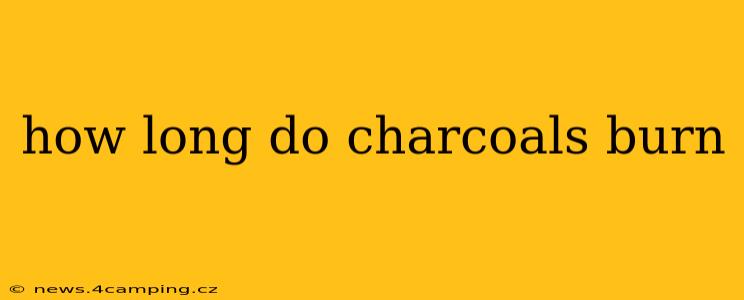Charcoal burning time depends on several factors, making it impossible to give a single definitive answer. Understanding these factors is key to enjoying a successful barbecue or campfire. This guide will delve into the intricacies of charcoal burn times, answering common questions and providing tips for maximizing your charcoal's lifespan.
What Factors Affect Charcoal Burning Time?
Several factors significantly influence how long your charcoal will burn:
-
Type of Charcoal: Briquettes burn longer and more consistently than lump charcoal. Briquettes are often treated with additives to improve their burning characteristics and extend their burn time. Lump charcoal, while offering a more intense, pure flavor, tends to burn faster and less consistently.
-
Charcoal Size and Shape: Larger pieces of charcoal will burn longer than smaller ones, simply because they have more fuel to consume. Similarly, the shape impacts the surface area exposed to oxygen, influencing burn rate.
-
Amount of Charcoal Used: More charcoal means a longer burn time. However, using excessive charcoal can lead to wasted fuel if you don't need the extra heat.
-
Airflow/Ventilation: Proper airflow is crucial for combustion. Insufficient airflow will result in a slow, smoldering burn, while excessive airflow can lead to rapid burning. Chimney starters and vents on grills help regulate airflow.
-
Ambient Temperature and Wind: Colder temperatures and strong winds can impact burn times. Cold weather slows down the chemical reactions involved in combustion, while wind can accelerate the burn by supplying more oxygen.
-
Moisture Content: Damp charcoal will burn less efficiently and for a shorter duration than dry charcoal. Storing charcoal in a dry, covered area is essential.
How Long Do Briquettes Burn?
Generally, briquettes can burn for 3-4 hours under optimal conditions. However, this can vary significantly based on the factors mentioned above. Some high-quality briquettes claim even longer burn times.
How Long Does Lump Charcoal Burn?
Lump charcoal typically burns for 1-2 hours, significantly shorter than briquettes. Its faster burn provides intense heat, ideal for searing, but requires more frequent replenishment for longer cooking sessions.
How Can I Make My Charcoal Burn Longer?
-
Use a Chimney Starter: This helps to get the charcoal burning efficiently and evenly, maximizing burn time.
-
Control Airflow: Adjust vents on your grill or campfire to manage the airflow and control the burn rate.
-
Use Enough Charcoal: Don't skimp on the amount of charcoal, particularly for longer cooking sessions.
-
Keep Charcoal Dry: Store your charcoal in a dry, covered place to prevent moisture absorption.
-
Arrange Charcoal Properly: Create a pyramid or mound shape to enhance airflow and even burning.
-
Use a Charcoal Basket: For campfires or open fires, a charcoal basket helps to contain the coals and provides better airflow.
What's the Difference Between Briquettes and Lump Charcoal?
The main difference lies in their composition and burning characteristics. Briquettes are made from compressed charcoal dust and additives, resulting in a longer, more consistent burn. Lump charcoal, on the other hand, is made from larger pieces of wood charred to remove volatile compounds, providing a faster, more intense heat, favored by many for its pure flavor.
How Do I Know When My Charcoal Is Ready?
Your charcoal is ready when it is covered in a light gray ash and glows brightly with minimal flames. Avoid using charcoal that is still producing significant flames, as this indicates incomplete combustion and potential for uneven cooking temperatures.
By understanding the various factors affecting charcoal burn time, you can better manage your grilling or campfire sessions and achieve optimal results. Remember to prioritize safety and always use appropriate safety measures when handling hot coals.
